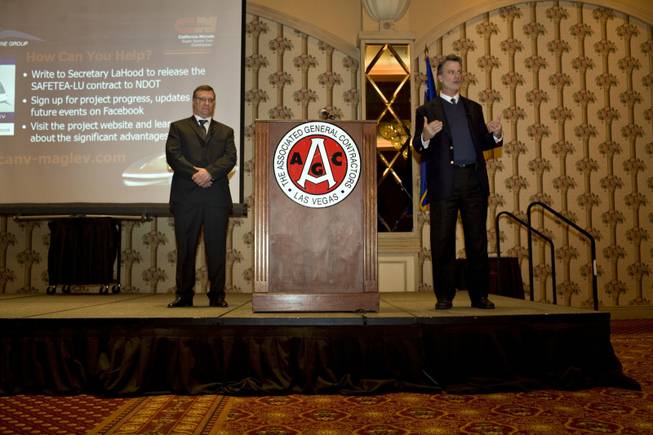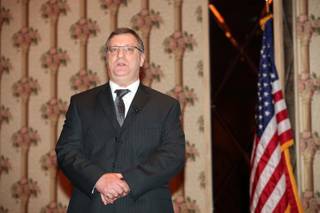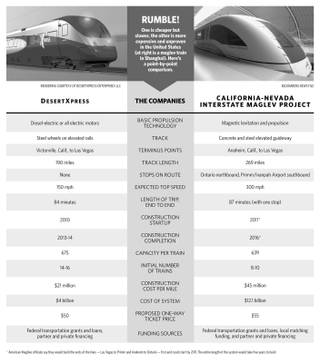
Thomas Bordeaux, senior transportation manager of Parsons Transportation, left, and Neil Cummings, president of American Magline Group speak to the Associated General Contractors luncheon Thursday at the Orleans about the progress of the maglev project and how it will impact construction jobs.
Friday, Jan. 22, 2010 | 2:05 a.m.
Sun Archives
- DesertXpress prepared to build; maglev, monorail extension on hold (1-15-2010)
- Maglev train to press on without Reid (6-10-2009)
- Reid sides with Desert Xpress fast train option (6-9-2009)
- State sends no representative to talk on high-speed trains (6-5-2009)
- Obama outlines vision for high-speed rail network (4-16-2009)
- 8 states seek stimulus money for high-speed rail (4-15-2009)
- No waste in rail dream (3-5-2009)
- Economic crisis an opportunity to be greener (3-1-2009)
- Vegas, Midwest seek the $8 billion for fast trains (2-23-2009)
- Calif. bond would launch bullet train project (9-26-2008)
Sun coverage
The American Magline Group didn’t have a difficult time Thursday convincing general contractors to support its plan to build a magnetic levitation train from Las Vegas to Anaheim.
It just took one promise — 90,000 jobs.
Neil Cummings, president of the group, and Thomas Bordeaux, deputy project manager from Parsons Transportation, spoke to more than 250 people at the quarterly Associated General Contractors luncheon at the Orleans.
The plan may need their support before it can deliver on the promise to employee all those construction workers.
“There’s a lot of aspects of this project that’s going to rely on general contractors here in Southern Nevada, and it cannot be built without them. Our business plan is dependant on that,” Bordeaux said.
Cummings told the contractors that their help was going to be key in getting the federal government to support the project instead of others around the country.
“It can happen here. It will happen here with your help, because you’re the ones that are going to build it,” Cummings said. “I’m just a lawyer and I can talk, but you guys can build it, so we’re counting on you help us.”
After 20 years of work, the project has been struggling as support has been building for the competing DesertXpress project, a proposed high-speed wheels-on-steel train line to Victorville.
That project is privately funded and backers say construction could begin within a year.
The maglev train uses new technology that would provide a faster trip, and a trip all the way into Southern California’s population center.
But it is more expensive, and federal transportation officials haven’t delivered on promised funds to work on the final design and engineering aspects of the project.
Cummings asked the contractors to contact Transportation Secretary Ray LaHood and their congressional representatives, even providing form letters for them to use.
The contractors seemed eager to reject the DesertXpress project in favor of the maglev train.
One audience member asked if the “ludicrous idea of the competition building a train to Victorville” was dead.
It’s not, but many of the contractors said they felt the maglev train would be better for Southern Nevada and they have hope for how the project could benefit their companies.
“It will bring jobs to the market,” said David Dieleman from Dielco Crane. “It would be a good boost for a lot of local contractors, maybe not us as much as other companies, but it could be a boost for us, too.”
Plus, the train would bring more tourists to Las Vegas, which could spur more construction, Dieleman said.
“It’s not just the short-term job growth,” he said. “If you can open up the market to millions more people, it would be a big boost to the whole area.”
Cummings said the project would be beneficial to Las Vegas and everywhere along the route where stations are built.
“This project is something that could really revitalize the entire valley,” he said.
The train, which would provide an 81-minute trip to Anaheim once completed, will cost $12.1 billion to build, Cummings said. It will be built in segments, each of which should be profitable, he said.
Bordeaux said the project will be labor intensive and may even exceed the capacity of Las Vegas contractors.
Once the project is built, the contractors would be the first with experience with the new technology, which could lead to other jobs, Cummings said.
Sean Stewart from Aggregate Industries left the presentation as a supporter of the project.
“I think it’s the future of travel in between the two places,” he said. “This is something we’d love to participate in and it would be a great boost to our economy.”



Join the Discussion:
Check this out for a full explanation of our conversion to the LiveFyre commenting system and instructions on how to sign up for an account.
Full comments policy